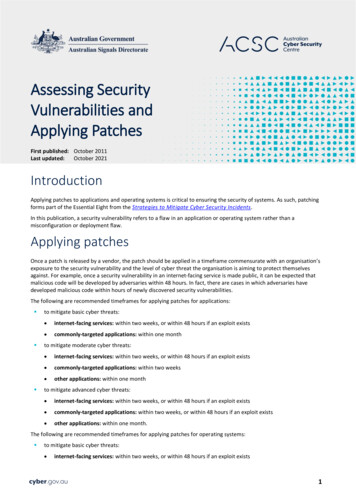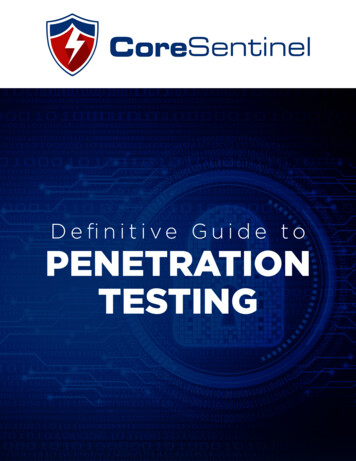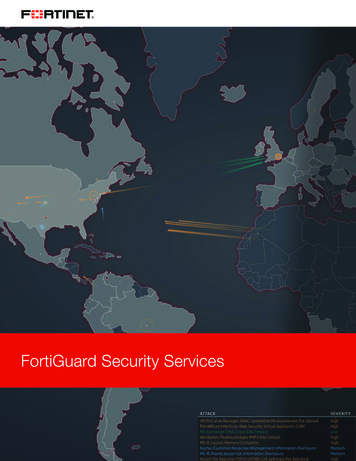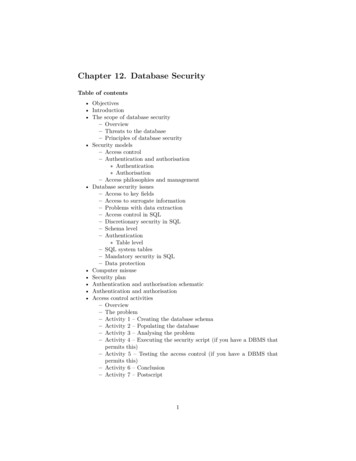
Transcription
Assessing SecurityVulnerabilities andApplying PatchesFirst published: October 2011Last updated:October 2021IntroductionApplying patches to applications and operating systems is critical to ensuring the security of systems. As such, patchingforms part of the Essential Eight from the Strategies to Mitigate Cyber Security Incidents.In this publication, a security vulnerability refers to a flaw in an application or operating system rather than amisconfiguration or deployment flaw.Applying patchesOnce a patch is released by a vendor, the patch should be applied in a timeframe commensurate with an organisation’sexposure to the security vulnerability and the level of cyber threat the organisation is aiming to protect themselvesagainst. For example, once a security vulnerability in an internet-facing service is made public, it can be expected thatmalicious code will be developed by adversaries within 48 hours. In fact, there are cases in which adversaries havedeveloped malicious code within hours of newly discovered security vulnerabilities.The following are recommended timeframes for applying patches for applications: to mitigate basic cyber threats: internet-facing services: within two weeks, or within 48 hours if an exploit exists commonly-targeted applications: within one monthto mitigate moderate cyber threats: internet-facing services: within two weeks, or within 48 hours if an exploit exists commonly-targeted applications: within two weeks other applications: within one monthto mitigate advanced cyber threats: internet-facing services: within two weeks, or within 48 hours if an exploit exists commonly-targeted applications: within two weeks, or within 48 hours if an exploit exists other applications: within one month.The following are recommended timeframes for applying patches for operating systems: to mitigate basic cyber threats: internet-facing services: within two weeks, or within 48 hours if an exploit exists1
workstations, servers, network devices and other network-connected devices: within one monthto mitigate moderate cyber threats: internet-facing services: within two weeks, or within 48 hours if an exploit exists workstations, servers, network devices and other network-connected devices: within two weeksto mitigate advanced cyber threats: internet-facing services: within two weeks, or within 48 hours if an exploit exists workstations, servers, network devices and other network-connected devices: within two weeks, or within48 hours if an exploit exists.Patching considerationsIdentifying missing patchesOne problem faced by many organisations is a lack of visibility of the true patch status of their environment. This canleave organisations unknowingly exposed to exploitation by adversaries or otherwise thinking that patches had beenapplied, or reported that they had been applied, when they had failed to be applied successfully. Using vulnerabilityscanners can assist organisations to gather information on missing patches in their environment. In cases wherevulnerability scanners can’t be used, organisations should refer to vendor documentation on how to identify patchinglevels and conduct manual audits instead.The following are recommended timeframes for conducting vulnerability scans for missing application patches: to mitigate basic cyber threats: internet-facing services: daily commonly-targeted applications: fortnightly other applications: as requiredto mitigate moderate cyber threats: internet-facing services: daily commonly-targeted applications: weekly other applications: fortnightlyto mitigate advanced cyber threats: internet-facing services: daily commonly-targeted applications: weekly other applications: fortnightly.The following are recommended timeframes for conducting vulnerability scans for missing operating system patches: to mitigate basic cyber threats: internet-facing services: daily workstations, servers, network devices and other network-connected devices: fortnightlyto mitigate moderate cyber threats:2
internet-facing services: daily workstations, servers, network devices and other network-connected devices: weeklyto mitigate advanced cyber threats: internet-facing services: daily workstations, servers, network devices and other network-connected devices: weekly.Patching during change freeze periodsChange freeze periods are typically periods of time when changes are minimised, usually to preserve businessoperations during critical periods. However, most organisations still allow emergency changes and patching activitiesduring change freeze periods via an exemption process.In theory, the tenet of freezing almost all changes in order to preserve business operations is sound. However, intoday’s constantly evolving cyber threat landscape, it is important to keep in mind that new security vulnerabilitiescontinue to be discovered by adversaries, vendors and security researchers, and that adversaries continue to operateirrespective of an organisation’s self-imposed change freeze period.The discovery of new security vulnerabilities, and disruptions from adversaries, may occur at any time. As such,organisations should ensure that security vulnerabilities are still being addressed during change freeze periods,especially within 48 hours for any internet-facing services. Critical security vulnerabilities, or security vulnerabilities thataffect critical applications or operating systems, should also be addressed with patches or other recommendedmitigations from vendors during change freeze periods. In some cases, vendor mitigations that are not traditionalpatches will be provided before a patch, or alongside a patch if the patch is disruptive. Where vendor mitigations areinitially used, patches should be applied as a follow-up.Faults during patchingWhen patching, organisations may be concerned about the risk of patches breaking applications or operating systems,and the associated outage this may cause. While this is a legitimate concern, and should be considered when decidingwhat actions to take in response to security vulnerabilities, many vendors perform thorough testing of patches prior totheir release. However, this testing is not always perfect and organisations are likely to at some point face the releaseof faulty patches or experience faults when attempting to apply patches to applications or operating systems.It is recommended that organisations account for the possibility of faults during patching by establishing clear patchmanagement processes. In doing so, organisations might adopt different strategies for managing faulty patches, forexample, larger organisations might test all patches beforehand in a testing or staging environment, whereas smallerorganisations might choose to forgo testing and instead implement a rollback mechanism. Organisations using modernsoftware environments and deployment approaches can more easily rollback their applications or operating systems toa known good state.Overall, the immediate protection afforded by patching a security vulnerability that is currently being exploited byadversaries far outweighs the impact of the unlikely occurrence of having to roll back a patch.Tightly coupled security and feature patchesIt is always recommended that security patches be applied as soon as possible. However, some vendors do not provideseparate security and feature update patches. If an organisation does not require a new feature, being forced to applythe new feature by a vendor could introduce business process risks, as certain business processes may rely on featuresremaining unchanged.Organisations should review vendor release notes and keep up-to-date on the types of updates and securityconfigurations that vendors provide. They should then determine if using products with tightly coupled security and3
feature patches is a risk or not. Any potential risk that has been identified may increase during change freeze periodswhere possible disruptions to business operations due to feature changes is especially undesirable.If organisations choose to use products from vendors that don’t provide security-only patches, they need to account forthis in their patch management processes, as they may need to be ready to implement feature changes at short noticeif security vulnerabilities are being exploited and require immediate patching.Patching in resource constrained environmentsIn situations where resources are constrained, organisations are encouraged to prioritise the deployment of patches.For example, patches should first be applied for all internet-facing services. This should then be followed by importantnetwork devices, servers and workstations of high-risk users (e.g. senior managers and their staff; systemadministrators; and staff members from human resources, sales, marketing, finance and legal areas). Finally, all othernetwork devices, servers and workstations should be patched.Temporary workaroundsTemporary workarounds may provide the only effective protection if there are no patches available from vendors forsecurity vulnerabilities. These workarounds may be published in conjunction with, or soon after, security vulnerabilityannouncements. Temporary workarounds may include disabling the vulnerable functionality within an application oroperating system, or restricting or blocking access to the vulnerable service using firewalls or other security controls.Patching in different contextsThe following considerations are applicable for organisations that use cloud services or operate critical infrastructure.Cloud infrastructureFor organisations that use externally-provided cloud services, the technology stack and secure administration processesimplemented are often opaque. However, this is unlikely to provide a significant risk if the cloud service provider (CSP)properly patches their infrastructure and systems as CSPs are required to provide a consistent and reliable service totheir customers.In terms of change freeze periods, if an organisation freezes change at the operating system layer when usingInfrastructure-as-a-Service, all of their data, resources and configurations should remain the same even if the CSPperforms changes underneath that layer. Similarly, if an organisation freezes change at the application layer when usingSoftware-as-a-Service, they should not notice any difference even if the CSP migrates the application across differentoperating systems.Separately, in order to flexibly and efficiently control changes for infrastructure they manage, organisations that arecloud-native might consider utilising Agile and Continuous Integration/Continuous Delivery/Deployment (CI/CD)development methodologies. This allows organisations to rapidly deploy and test patches in a controlled manner.Moving to the cloud entails not only the transformation of technical architecture, but also the transformation ofbusiness processes.Finally, information on the security responsibilities of CSPs and their customers can often be found via a CSP’s sharedresponsibility model and service-level agreements. For example, organisations should note that they are stillresponsible for patching their applications and operating systems when using Infrastructure-as-a-Service.4
Critical infrastructureCritical infrastructure, such as Industrial Control Systems, are unique in the sense that they are often in a state ofchange freeze due to their requirement of high availability. Organisations with critical infrastructure will most likelyfavour manual patching over automated patching, and find through risk assessments that it is riskier to patch than it isto withhold from patching. These organisations should still seek to apply mitigations to address any identified securityvulnerabilities. For example, network monitoring and segmentation might be applied instead of patching. It is up toorganisations to define patch management processes that are in line with their business requirements and threatprofile.SummaryBy maintaining a clear and streamlined patch management process – including an awareness of information sourcesused to determine whether security vulnerabilities are currently being exploited, an awareness of the regular patchrelease schedules of vendors, defined responsibilities for individuals involved in patching activities and regularvulnerability scanning for missing patches – organisations can position themselves to act swiftly upon security bulletinor patch releases. In doing so, organisations can dramatically reduce the time between noticing information on newsecurity vulnerabilities and applying patches, or implementing temporary workarounds where appropriate.Further informationThe Information Security Manual is a cyber security framework that organisations can apply to protect their systemsand data from cyber threats. The advice in the Strategies to Mitigate Cyber Security Incidents, along with its EssentialEight, complements this framework.Contact detailsIf you have any questions regarding this guidance you can write to us or call us on 1300 CYBER1 (1300 292 371).5
1 Introduction Applying patches to applications and operating systems is critical to ensuring the security of systems. As such, patching forms part of the Essential Eight from the Strategies to Mitigate Cyber Security Incidents. In this publication, a security vulnerability refers to a










